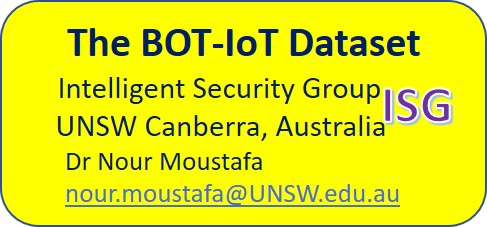The BoT-IoT dataset can be downloaded from HERE. You can also use our new datasets: the TON_IoT and UNSW-NB15.
--------------------------------------------------------------------------
The BoT-IoT dataset was created by designing a realistic network environment in the Cyber Range Lab of UNSW Canberra. The network environment incorporated a combination of normal and botnet traffic. The dataset’s source files are provided in different formats, including the original pcap files, the generated argus files and csv files. The files were separated, based on attack category and subcategory, to better assist in labeling process.
The captured pcap files are 69.3 GB in size, with more than 72.000.000 records. The extracted flow traffic, in csv format is 16.7 GB in size. The dataset includes DDoS, DoS, OS and Service Scan, Keylogging and Data exfiltration attacks, with the DDoS and DoS attacks further organized, based on the protocol used.
To ease the handling of the dataset, we extracted 5% of the original dataset via the use of select MySQL queries. The extracted 5%, is comprised of 4 files of approximately 1.07 GB total size, and about 3 million records.
--------------------------------------------------------------------------
Free use of the Bot-IoT dataset for academic research purposes is hereby granted in perpetuity. Use for commercial purposes should be agreed by the authors. The authors have asserted their rights under the Copyright. To whom intent the use of the Bot-IoT dataset, the authors have to cite the following papers that has the dataset’s details: .
- Koroniotis, Nickolaos, Nour Moustafa, Elena Sitnikova, and Benjamin Turnbull. "Towards the development of realistic botnet dataset in the internet of things for network forensic analytics: Bot-iot dataset." Future Generation Computer Systems 100 (2019): 779-796. Public Access Here.
- Koroniotis, Nickolaos, Nour Moustafa, Elena Sitnikova, and Jill Slay. "Towards developing network forensic mechanism for botnet activities in the iot based on machine learning techniques." In International Conference on Mobile Networks and Management, pp. 30-44. Springer, Cham, 2017.
- Koroniotis, Nickolaos, Nour Moustafa, and Elena Sitnikova. "A new network forensic framework based on deep learning for Internet of Things networks: A particle deep framework." Future Generation Computer Systems 110 (2020): 91-106.
- Koroniotis, Nickolaos, and Nour Moustafa. "Enhancing network forensics with particle swarm and deep learning: The particle deep framework." arXiv preprint arXiv:2005.00722 (2020).
- Koroniotis, Nickolaos, Nour Moustafa, Francesco Schiliro, Praveen Gauravaram, and Helge Janicke. "A Holistic Review of Cybersecurity and Reliability Perspectives in Smart Airports." IEEE Access (2020).
- Koroniotis, Nickolaos. "Designing an effective network forensic framework for the investigation of botnets in the Internet of Things." PhD diss., The University of New South Wales Australia, 2020.
--------------------------------------------------------------------------
There are many new approaches in Intrusion Detection, Network Forensics and Privacy-Preservation in different systems such as networking, IoT, Industry 4.0 and cloud, that could be used and citied:
- Ashraf, Javed, Marwa Keshk, Nour Moustafa, Mohamed Abdel-Basset, Hasnat Khurshid, Asim D. Bakhshi, and Reham R. Mostafa. "IoTBoT-IDS: A Novel Statistical Learning-enabled Botnet Detection Framework for Protecting Networks of Smart Cities." Sustainable Cities and Society (2021): 103041.
- Moustafa, Nour, Marwa Keshk, Kim-Kwang Raymond Choo, Timothy Lynar, Seyit Camtepe, and Monica Whitty. "DAD: A Distributed Anomaly Detection system using ensemble one-class statistical learning in edge networks." Future Generation Computer Systems 118 (2021): 240-251.
- Weinger, Brett, Jinoh Kim, Alex Sim, Makiya Nakashima, Nour Moustafa, and K. John Wu. "Enhancing IoT Anomaly Detection Performance for Federated Learning." In 2020 16th International Conference on Mobility, Sensing and Networking (MSN), pp. 206-213. IEEE, 2020.
- Haider, Waqas, Nour Moustafa, Marwa Keshk, Amanda Fernandez, Kim-Kwang Raymond Choo, and Abdul Wahab. "FGMC-HADS: Fuzzy Gaussian mixture-based correntropy models for detecting zero-day attacks from linux systems." Computers & Security 96 (2020): 101906.
- Al-Hawawreh, Muna, Nour Moustafa, Sahil Garg, and M. Shamim Hossain. "Deep Learning-enabled Threat Intelligence Scheme in the Internet of Things Networks." IEEE Transactions on Network Science and Engineering (2020).
- Ashraf, Javed, Asim D. Bakhshi, Nour Moustafa, Hasnat Khurshid, Abdullah Javed, and Amin Beheshti. "Novel Deep Learning-Enabled LSTM Autoencoder Architecture for Discovering Anomalous Events From Intelligent Transportation Systems." IEEE Transactions on Intelligent Transportation Systems (2020).
-----------------------------------------------------------------------
For more information about the datasets, please contact the author,
Dr Nickolaos Koroniotis (n.koroniotis@unsw.edu.au) or
Dr Nour Moustafa (nour.moustafa@unsw.edu.au).
Last Updated: 02 June 2021
